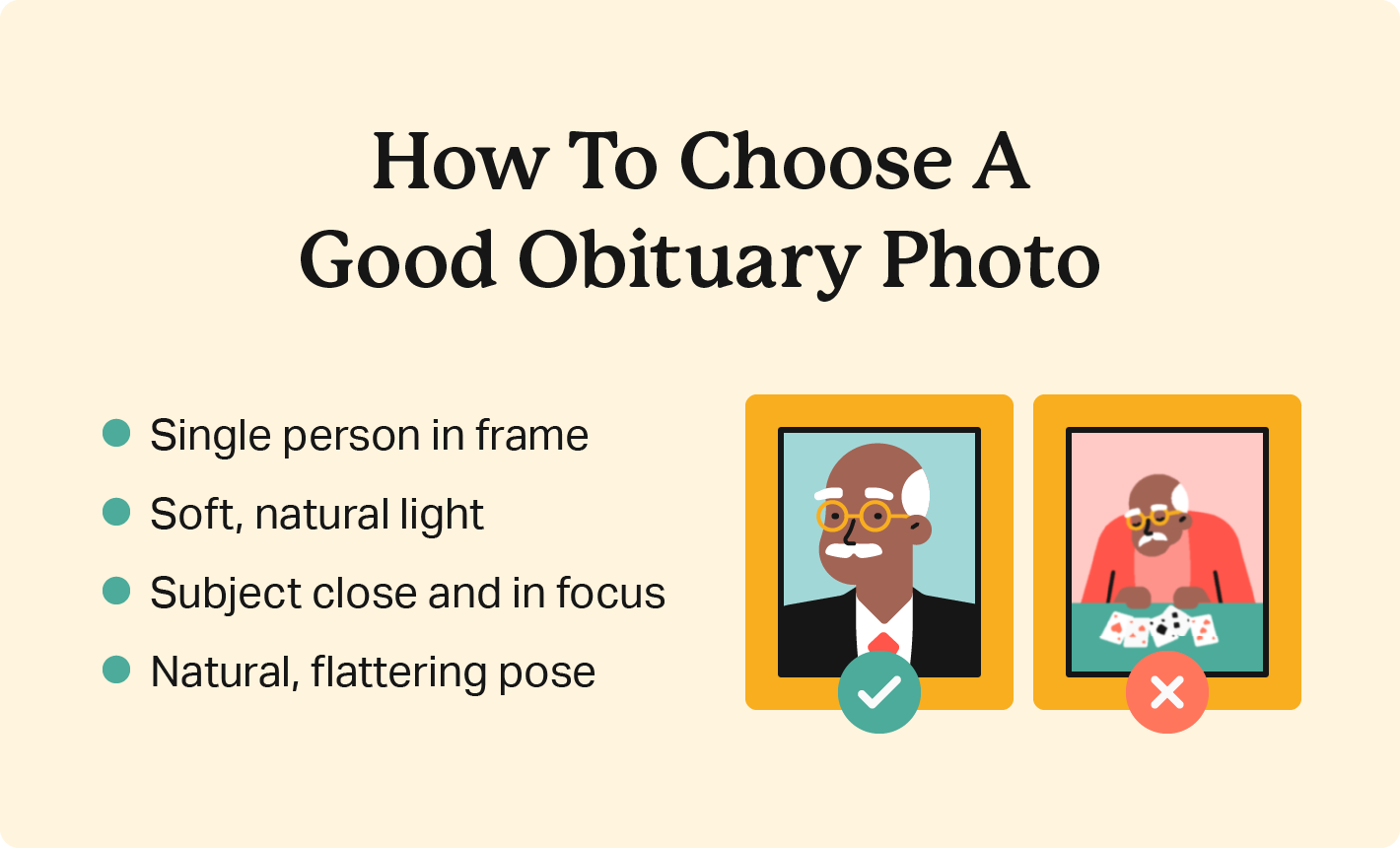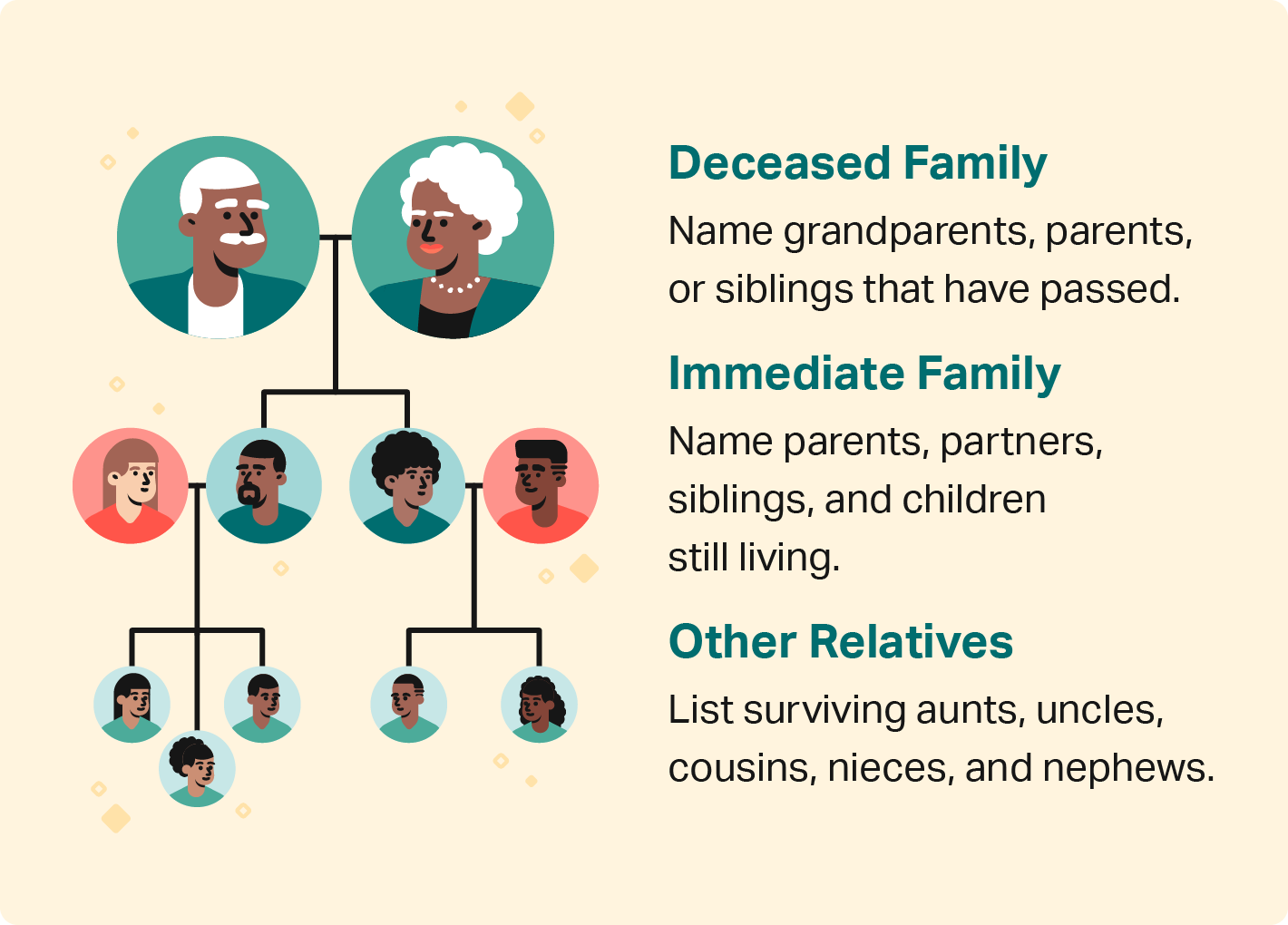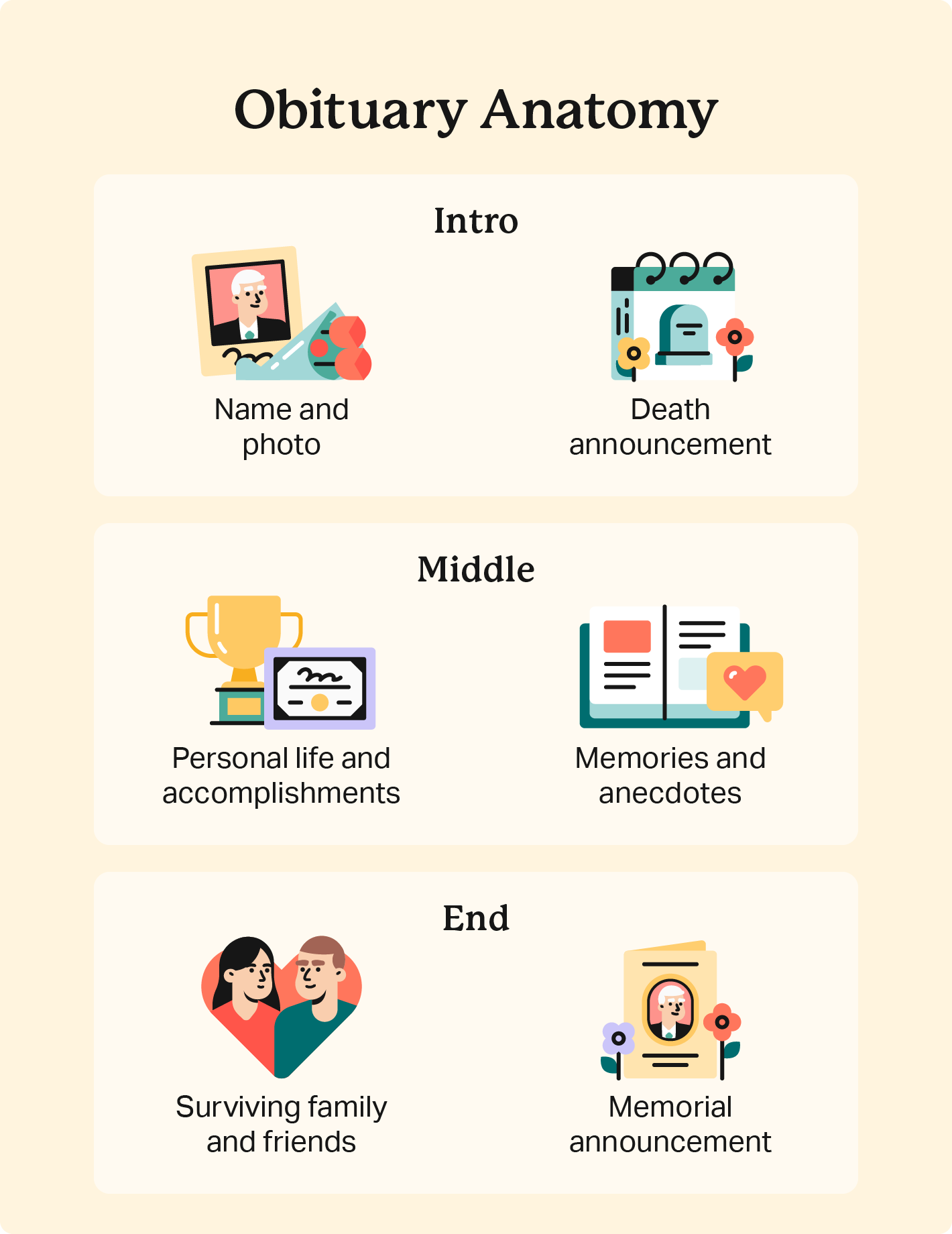Knowing how to write an obituary means understanding what details to mention, who to contact for support, and how to structure the personal details and stories you want to include.
The best obituaries include personal anecdotes, funny stories, and sweet memories along with the must-know personal details to celebrate the whole of your loved one’s life well-lived.
But, writing an obituary is an extremely emotional process that overlaps with the stress of funeral planning and arrangements. Getting creative and knowing how to write an obituary, what to include, and publishing it in a timely manner is challenging but far from impossible.
Follow these steps to organize your thoughts, and check out our obituary examples and template below to help you start writing.
1. Include A Photo
Most obituaries include the deceased’s photo to help people identify and learn a little more about them. The best obituary photos are clear, high-quality photos where you can clearly see the person’s face.
A photo’s recentness is entirely up to the family. Older photos from a favorite vacation or personal accomplishment are as great as the most recent professional portrait or smiling selfie.
Avoid busy or poor-quality photos that are hard to see, including:
- Blurry, out-of-focus images
- Small images that are difficult to resize or print
- Over- or under-exposed photos
- Group images
- Long-distance photos
- Inappropriate and unflattering images
If you don’t have many photos to choose from, reach out to friends and family, and you can reuse the extra images for a memorial slideshow.
2. Announce The Death
Obituaries typically begin with the person’s name, age, and death date and location. It’s optional to share the cause of death, and you should decide how to address this with the family.
There are several ways to announce a death with sensitivity. Here’s some language you may consider using:
- Passed away
- Departed
- Went to rest
- Entered eternal rest
- Lost their life
- Were called home
- Went to a better place
- Succumbed to …
3. Share Key Personal Facts
You’ll also want to introduce the basic facts about a person, including:
- Birth place
- Education
- Career
- Marriage and family
- Religion
These are pretty straightforward facts, but you can be creative about how much you share and how you share it.
For example, you can write that they were born a Cubs fan in Chicago, where they enjoyed summer games at Wrigley Field and fishing in Lake Michigan.
4. Highlight Their Life Accomplishments
A person’s life accomplishments are where you get to dig into what mattered the most to them. These can tie into their personal details or introduce totally new aspects of their personality, like:
- Career accomplishments
- Family pride
- Hobbies
- Community and volunteer work
- Memories from loved ones
These are much more personal stories that you can write about much more creatively. This section is about stories rather than facts, so it can be fun to chat with other family and friends to reminisce and agree on the best way to showcase how wonderful your loved one was and how much they’ll be missed.
5. Introduce Their Family
Family is an important part of people’s life and legacy and a natural conclusion to the personal life section of an obituary. Here you’ll name:
- Deceased relatives: names of mother, father, and siblings that have died
- Immediate family: names of living partners, children, parents, and other specific family members
- Close relatives: grouped relatives including grandchildren, nieces and nephews, aunts and uncles
You can include as many important people you want—even surviving pets, friends, and caretakers.
The list begins with the closest deceased relatives, then living survivors, and includes their names and partners, like this:
- [Name] is preceded in death by their parents, David and Suzanna Doe. They’re survived by their loving wife, Jane Doe, eldest son, Michael Doe (Deborah), and daughter Rachel Deer (Johnathon).
As relatives become more distant, obituaries become more general and list the relation and number of relations.
- [Name] also leaves behind four wonderful grandchildren, six nieces and nephews, and two dogs who miss them dearly.
6. Include Funeral And Memorial Details
After you cover the person’s personal life and accomplishments, include an invitation to any scheduled public memorial services. If you’re hosting a visitation, burial, or online memorial, include the:
- Date
- Time
- Location
- Website for more information
You can also list where to send flowers and other condolences and a link to an online guest book if you have one.
7. Finish With A Conclusion
You may choose to write a separate obituary conclusion with any additional details or acknowledgments. This can include donations for a beloved cause or an acknowledgment thanking people for their support and sympathy.
You may also choose to include a final goodbye or message of grief support with a funeral poem or prayer.
Obituary Template
Obituaries follow a common structure, so you can easily customize the outline and example template below to write an obituary that honors your loved one.
- First and last name
- Birth date – Death date
- Death announcement
- Name
- Age
- Death location
- Death date
- Personal details
- Interests
- Education
- Career
- Marriage/family
- Accomplishments
- Career goals
- Family accomplishments
- Hobbies
- Community engagements
- Family relations
- Deceased relatives
- Closest living relatives
- Additional relationships
- Service details
- Public services
- Location and time
- Donations
Riley Jordan Doe, Jr.
January 3, 1975 – April 19, 2023
Riley “Junior” Doe, 48, was born and raised in Atlanta, GA and peacefully went to rest on April 19, 2023, in their home surrounded by loved ones.
Riley always enjoyed adventure, taking their first big leap when they moved to New York City to study at Columbia University. They graduated with a creative writing degree and moved back to Atlanta with their new wife, Taylor, where they raised three children together.
Riley spent their best years as a traveling novelist, memorializing the canals in Greece, friends they made in the Philippines, and all of their greatest stories in books to share with the world.
They’re remembered as a loving father and community member back home, where Riley regularly spent time teaching workshops at the library and volunteering for all of their kids’ school trips and sports teams.
Riley is preceded in death by their father, John Doe, and eldest sister, Deborah Smith. They’re survived by their mother, Jane Doe; partner, Taylor Doe; children, Michael (Sammy) Doe, David Doe, and Jenny (Nick) Clark; and two nieces, aunts, and uncles.
Services will be held at McMillan’s Funeral Home, 555 Rainforest Dr., on Thursday, April 25, at 11 a.m., with a private burial service afterward.
Obituary Writing Tips
Writing an obituary isn’t easy when you factor in the emotional and time crunch. Plus, condensing someone’s whole life into a few short paragraphs is difficult. The key is to take your time, organize your thoughts, and reach out to others for help.
Here are some specific tips to help you know how to write an obituary and get started.
Work with other loved ones
There are likely other loved ones who will be happy to help you write an obituary. Extra helpers are great if you have questions or want to bounce ideas off someone. They’re also a helpful resource for verifying important details and proofreading the final draft before you send it to a publisher.
Looping others in can be extremely helpful, and the support can help you connect and grieve. But be careful you don’t ask too many folks for help. Too many writers can cause conflicting feedback, give you too much information to organize, or otherwise overwhelm the process.
Try to choose loved ones you trust, who knew the deceased well, and may already have experience writing an obituary to help.
Collect other personal stories and memories
While you’re working with other loved ones, ask them to share their favorite memories of the deceased. These are a great way to add character and personality to your obituary, so it isn’t just a list of facts.
Consider what type of story you want to showcase. Someone’s brother may have a hilarious childhood story to share, while their partner can talk about their greatest accomplishment as a family.
Start with questions to organize your thoughts
An outline is a good place to start if you’re having trouble writing. You can use the template above and ask yourself key questions to generate details and stories to include.
As you come up with answers, place them where they belong in the outline. Then, you can easily compare details for each section to decide what’s most important and tweak the answers to flow together.
- What are the must-have details?
- Who else knows this person so well that you can ask them for help?
- How would you and others describe the deceased in a few short words?
- What were the deceased’s greatest accomplishments?
- What hobbies and passions did your loved one engage with?
- How did they show up for the community?
- What’s your favorite memory of the deceased?
- How did they enjoy their days off?
- How did they show love to their friends and family?
- What causes were important to them?
Guarantee Funeral Funds With Final Expense Insurance
Planning a funeral isn’t easy. From navigating legal documents and final wishes to figuring out how to write an obituary, there’s much for the family to do during this stressful time.
Final expense insurance can provide you and your family with funds to cover your funeral costs without stress. Get a quote today and finalize your end-of-life wishes to provide you and your family some peace of mind.
- Nationally licensed life insurance agent with over 15 years of experience
- Personal annual production that puts him in the top .001% out of all life insurance agents in the nation.
Anthony Martin is a nationally licensed insurance expert with over 15 years of experience and has personally served over 10,000 clients with their life insurance needs. He frequently authors entrepreneurial and life insurance content for Forbes, Inc.com, Newsweek, Kiplinger, and Entreprenuer.com. Anthony has been consulted as an expert life insurance source for dozens of high-profile websites such as Forbes, Bankrate, Reuters, Fox Business, CNBC, Investopedia, Insurance.com, Yahoo Finance, and many more.
- Nationally licensed life insurance agent with over 19 years of experience
- Best selling Amazon author.
Jeff Root is a nationally licensed life insurance expert with over 19 years of experience. He has personally helped over 3000 clients with their life insurance needs. Jeff is a best-selling Amazon author and the managing partner of a highly successful insurance brokerage that manages over 2,500 licensed insurance agents across the USA. He has been a featured life insurance source for prestigious websites such as Forbes, Bloomberg, MarketWatch, Nerdwallet, and many more.
- Nationally licensed life insurance agent with over 14 years of experience
- Best selling Amazon author of five insurance sales books.
David Duford is a nationally licensed insurance expert with over 14 years of experience. He has personally helped more than 15,000 clients buy life insurance. David has been featured as an expert source for highly authoritative publications such as A.M. Best and Insurancenewsnet. He also runs one of the largest Youtube channels to help aspiring insurance agents serve their clients better.
- Nationally licensed life insurance agent with over 19 years of experience
- Best selling Amazon author.
Jeff Root is a nationally licensed life insurance expert with over 19 years of experience. He has personally helped over 3000 clients with their life insurance needs. Jeff is a best-selling Amazon author and the managing partner of a highly successful insurance brokerage that manages over 2,500 licensed insurance agents across the USA. He has been a featured life insurance source for prestigious websites such as Forbes, Bloomberg, MarketWatch, Nerdwallet, and many more.
- Nationally licensed life insurance agent with over 14 years of experience
- Best selling Amazon author of five insurance sales books.
David Duford is a nationally licensed insurance expert with over 14 years of experience. He has personally helped more than 15,000 clients buy life insurance. David has been featured as an expert source for highly authoritative publications such as A.M. Best and Insurancenewsnet. He also runs one of the largest Youtube channels to help aspiring insurance agents serve their clients better.











